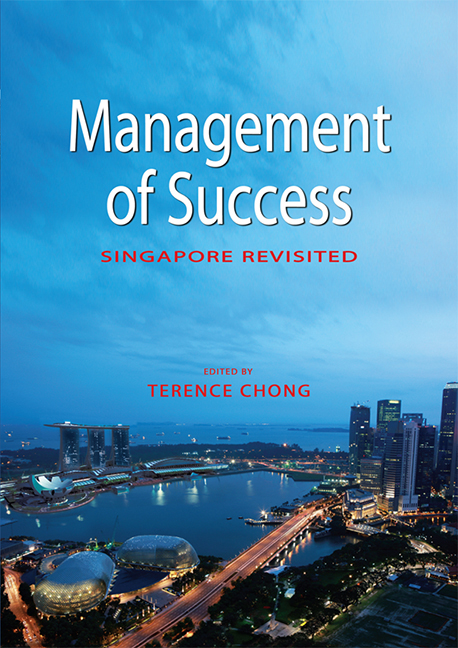Book contents
- Frontmatter
- Contents
- List of Tables and Figures
- Foreword
- Message
- Quote
- Preface
- The Contributors
- 1 Introduction: The Role of Success in Singapore's National Identity
- SECTION 1 SINGAPORE IN THE BIGGER PICTURE
- SECTION 2 LEADERSHIP, POLICY AND POLITICS
- SECTION 3 THE RESTRUCTURING OF THE ECONOMY
- SECTION 4 THE TRANSFORMATION OF SOCIETY
- 11 The Ageing Population
- 12 Managing Labour Flows: Foreign Talent, Foreign Workers and Domestic Help
- 13 Social Mobility in Singapore
- 14 Singapore's Print Media Policy: A National Success?
- 15 Control-shift: The Internet and Political Change in Singapore
- 16 The Transformation of Meritocracy
- 17 Education in Singapore: Sorting Them Out?
- 18 Religious Diversity in Singapore
- SECTION 5 THE LAW
- SECTION 6 MODIFICATION OF THE ENVIRONMENT
- SECTION 7 COMMUNITY AND NATIONAL SECURITY
- SECTION 8 LIFE IN SINGAPORE
- Index
18 - Religious Diversity in Singapore
from SECTION 4 - THE TRANSFORMATION OF SOCIETY
Published online by Cambridge University Press: 21 October 2015
- Frontmatter
- Contents
- List of Tables and Figures
- Foreword
- Message
- Quote
- Preface
- The Contributors
- 1 Introduction: The Role of Success in Singapore's National Identity
- SECTION 1 SINGAPORE IN THE BIGGER PICTURE
- SECTION 2 LEADERSHIP, POLICY AND POLITICS
- SECTION 3 THE RESTRUCTURING OF THE ECONOMY
- SECTION 4 THE TRANSFORMATION OF SOCIETY
- 11 The Ageing Population
- 12 Managing Labour Flows: Foreign Talent, Foreign Workers and Domestic Help
- 13 Social Mobility in Singapore
- 14 Singapore's Print Media Policy: A National Success?
- 15 Control-shift: The Internet and Political Change in Singapore
- 16 The Transformation of Meritocracy
- 17 Education in Singapore: Sorting Them Out?
- 18 Religious Diversity in Singapore
- SECTION 5 THE LAW
- SECTION 6 MODIFICATION OF THE ENVIRONMENT
- SECTION 7 COMMUNITY AND NATIONAL SECURITY
- SECTION 8 LIFE IN SINGAPORE
- Index
Summary
RELIGION IN SINGAPORE
Religious and ethno-religious issues are inherent in multi-ethnic and multi-religious societies, and Singapore is no exception. It has long been a multi-ethnic, multi-cultural and multi-religious society, being historically and contemporarily at the crossroads of some of the world's major and minor civilizations, cultures, religions, and traditions. Today, every major religious tradition in Singapore probably has within it a full religious spectrum, from orthodox, traditional orientations to reform movements and independent spiritual clusters, while other minor religions and movements have created or renewed spaces, membership, and expressions in the rapidly evolving city landscape. Most have regional and global links and influences. Religious affiliation is high and religious identification is strong among the population. These have also occurred against a background of growing religiosity and religious change since the 1970s. Global, regional and local events and developments since September 11 have further put the spotlight on religion, and raised issues concerning religious identity, politics, and inter-religious relations, and their impact on social cohesion.
Despite the diverse and dynamic religious landscape, however, there is a lack of in-depth knowledge, nuanced understanding, and regular dialogue about various religions and the meanings of living in Singapore's multi-religious world. Indeed, claims of ignorance, lack of inter-religious understanding, dialogue, and interaction, negative stereotyping and other inter-religious encounters among individuals and groups present potential points of misunderstanding and tension. Some overlaps between ethnicity and religion further lend a heightened dimension and significance to ethno-religious identities and issues. While much is happening on the ground, recent studies and published literature are few or limited in scope and research has generally fallen behind realities and developments. Literature on various religions, while abundant, tends to be focused on their respective religious concerns and congregations. There is a lack of systematic studies or surveys and little on religion in national census coverage.
This chapter provides an overview of religious diversity in Singapore. In a broad examination of the larger religious landscape, it highlights some general developments and trends among the multi-religious population, in relations between the secular state and the multi-religious society, and within specific religions. The complex religious landscape is then illustrated and explored through relevant or significant aspects, issues and examples in some specific domains and among particular populations: schools/education and the young, media and social services.
- Type
- Chapter
- Information
- Management of SuccessSingapore Revisited, pp. 309 - 332Publisher: ISEAS–Yusof Ishak InstitutePrint publication year: 2010

